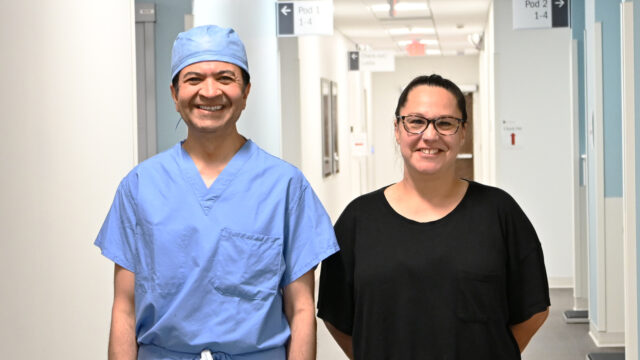Robotic Mitral Valve Repair Surgery
The least invasive approach to repairing or replacing your leaky valve
When a patient has a leaky heart valve or one that doesn’t open well, it can cause signs and symptoms of heart failure. These are indications for mitral valve surgery. Robotic mitral valve repair is a minimally invasive form of heart surgery that offers patients much faster recovery than traditional surgery.
What to Expect with Mitral Valve Repair Surgery
The mitral valve controls blood flow on the left side of the heart. Robotic mitral valve repair surgery (MVR) is the procedure of choice at IU Health to fix leaking mitral valves.
Rather than opening the chest through the breastbone in a traditional sternotomy procedure, robotic MVR uses the da Vinci XI Robotic Surgical System to enter the chest through three small incisions, the largest measuring about an inch in length. The cardiac surgeon uses the other, smaller openings to insert instruments, like the camera and robotic surgical tools.
In rare cases, the mitral valve cannot be repaired and must be replaced. This can happen if the mitral valve is very damaged or it's blocked (stenotic). Robotic surgery is also an option for valve replacement as well as repair.
The robotic MVR team at IU Health is led by a cardiac surgeon with more than 20 years of experience developing this unique skill set. The surgical team is specialized in performing this procedure regularly, sharpening their skills through high volumes of care.
Preparing For Mitral Valve Repair Surgery
Prior to robotic MVR surgery, it’s important that patients continue taking their medicines as directed. Recovery will improve if patients stop smoking and follow a healthy diet and activity levels before the procedure.
What specific experience does the surgical team have in mitral valve repair surgery?
Questions to Ask Your Provider
What specific experience does the surgical team have in mitral valve repair surgery?
After Your Mitral Valve Repair Surgery
Though it’s still open-heart surgery, recovery from robotic mitral valve repair surgery is vastly different than from a minimally invasive sternotomy. Patients typically leave the hospital just a few days after the procedure. It’s normal to have pain at the surgery site for the first few days after surgery. The surgeon will place a drainage tube from chest to collect fluid and keep the lungs expanded for easier breathing. Your doctor will remove the drainage tube a day or two after surgery.
Patients recovering from robotic MVR surgery often have little or no physical restrictions, allowing you to return sooner to work and life than you would with a sternotomy. This type of surgery has a mortality rate of less than 1%, which varies depending on a patient’s other medical conditions.
Frequently Asked Questions
What are my options if my heart valve must be replaced?
Your mitral valve can be replaced with one of two options: either a mechanical, man-made valve or a biological prosthetic valve from a pig. The mechanical valve lasts longer but requires the patient to take anti-clotting medication; the porcine (pig) valve lasts about 15 years but is less likely to cause clots.
If my mitral valve needs replaced, does my replacement surgery need to be a traditional sternotomy or can I have a robotic MVR?
If your mitral valve needs to be replaced, you are likely still a candidate for robotic MVR surgery. In fact, fewer than one in 100 robotic MVRs unexpectedly require sternotomy instead of robotic MVR.


